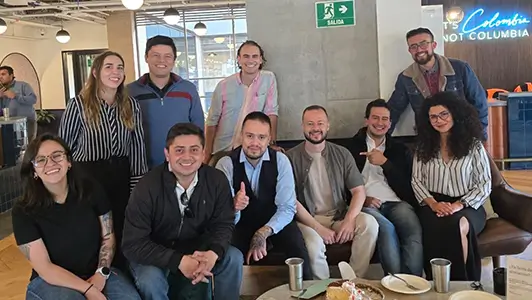As we venture through the cosmos of technology, armed with our metaphorical towels (essential for any galactic hitchhiker), we reflect on 2023 – a pivotal year in the odyssey of generative AI. It’s been a year where “Don’t Panic” wasn’t just a comforting motto emblazoned on the cover of an interstellar guidebook but a necessary mantra for businesses and technologists navigating the vast and often absurd galaxy of AI.
We began 2023 with the rush and excitement provided by an interactive artificial intelligence – one that could answer questions and create content. For some, this exciting advancement was just a matter of time. For many others, these five letters comprising Gen AI would thrust them into a world they’d only ever seen through a Hollywood lens.
Applications of generative AI in 2023
At the beginning of 2023, the tech world, much like the rest of society, oscillated between extreme optimism and doomsday predictions when it came to generative AI. The fear of job displacement loomed large, a specter of technology rendering human effort obsolete4. Misinformation and deception were also major concerns, as the ease of generating fake content using AI threatened the very fabric of truth3.
Amidst these fears, there was also an air of exhilaration about the potential of AI to augment human capabilities, take on the mundane, and free us for higher pursuits – a sentiment echoed by many, including Sam Altman, CEO of OpenAI2.
Just like a towel in “The Hitchhiker’s Guide to the Galaxy,” generative AI in 2023 served as a versatile must-have-don’t-leave-home-without-it tool. It aided in content creation, programming, education, and customer service, highlighting its role as an enhancer rather than a displacer of human skills1. The rise of AI in the arts, from generating art to composing music, showcased the technology’s ability to collaborate with human creativity, proving that the sum of human and AI capabilities is indeed greater than its parts (one plus one is greater than two, anyone?) 1. That said, there is merit in discussing whether generative AI is truly creating in the sense a human creates. We’ll save that exploratory debate for another time.
Navigating the bureaucracy and inefficiency of Gen AI: The Vogon-esque Hurdles
However, the journey wasn’t without its bureaucratic hurdles, reminiscent of the Vogons in Douglas Adams’ universe. The need for ethical AI governance and the challenges in addressing biases and privacy concerns highlighted the sector’s struggles against its own inefficiency and complexity1. With great power comes great responsibility?
Let’s not forget the range of reactions, from countries choosing to completely ban all from accessing ChatGPT to organizations pleading with their employees to refrain from asking questions on public Gen AI using company secrets. Organizations scrambled to understand what this new world of governance must look like, and teams and business functions positioned themselves strategically to take ownership of this newly founded power. And for some (if not many), the inadequacy of existing governance capabilities was catapulted into the limelight.

The absurdity of human nature: Uncovering the extremes in AI perception
In true Hitchhiker’s fashion, 2023 also highlighted the absurdity of human nature – our tendency to swing between unbridled enthusiasm and crippling fear over AI. While some heralded AI as the dawn of a new era, others saw it as an existential threat, a narrative that gained traction, but not without its detractors who called these fears “preposterously ridiculous”4.
My personal favorite was the rate at which the social media influencer community pounced on the hype. You could easily offer each team member at a Fortune 500 company a unique “Prompt Engineering HOWTO” placemat created by a social media influencer at the annual company holiday party. Let’s also recognize those who took Gen AI chat utilities on a dark joy ride, encouraging the predictive response algorithms to create responses that clearly violate the most basic of ethics. We, as humans, love to celebrate creativity by showing how that same creativity can be wielded for destruction.
The power of imagination: AI’s role in shaping the future
Much like the boundless realms of space explored in “The Hitchhiker’s Guide…,” the landscape of generative AI in 2023 was a testament to human imagination. The advancements in AI not only reflected our technological prowess but also underscored our capacity to envision and create a future where technology amplifies human potential. The integration of AI in business and industry demonstrated its transformative power, enhancing efficiency and innovation across various sectors1.
Many millennia from now, a poor sap will write a dissertation on the early era of AI and see a strange spike in the use of the word “Copilot.” As an instrumented-rated private pilot, I struggle with the use of this word. I expect my “copilot” to have some autonomy to know what to do without being prompted in some way. Be that as it may, it’s clear we’re careful as a society to label this amazing new technology as something meant to assist vs. displace or overtake humans. Adoption does require some form of disarmament.
As we tread through this nebulous terrain of AI and its implications, the Hitchhiker’s mantra of “Don’t Panic” serves as a beacon. The year 2023, with all its technological upheavals, has shown us that while the path of AI is uncertain, it is navigable with caution, awareness, and collaboration. The growing public understanding and AI literacy have been crucial in demystifying AI, equipping individuals to interact with and harness its capabilities effectively1.

One of the best ideas I’ve heard yet is the proposal that, like biohazard facilities, there might exist some “level” concept where AI has increasing levels of capability. Working with more advanced levels requires demonstrating to some regulatory body that your organization is equipped to manage that power and use it for “good.”
Whether that emerges as the way forward, the important thing is that we’re stopping to ponder one of the wisest considerations: just because we can doesn’t mean we should. It’s hard not to imagine a world painted by Pixar’s world of WALL-E where humans have created a utopia, removing all discomforting demands on a human’s time (though floating chairs, eating all meals through a straw, and interacting only through screens doesn’t necessarily appeal to me).
Some will continue to push the edges of “what’s possible,” and others will balance that force by questioning if we’ve gone too far. We must be vigilant as galactic explorers to ensure we don’t inadvertently sacrifice something as precious as a planet as did the Vogon Constructor fleet building an interspace bypass.
Recommendations to embrace Gen AI in the near term
As we chart the course for the future, here are some recommendations for businesses:
1. Focus on human-AI collaboration
Embrace AI as a partner rather than a replacement. Encourage initiatives that combine human creativity with AI’s efficiency, capitalizing on the unique strengths of both. Make one plus one greater than two instead of one minus one equal to zero.
2. Invest in ethical and governed AI practices
Develop and enforce ethical guidelines and governance structures to address AI-related risks like inaccuracy and privacy concerns. This is essential to maintain trust and integrity in AI applications. Create boundaries vs. restrictions and guide your teams toward responsible use vs. no use at all.
3. Build a data foundation
Gen AI makes it look deceptively simple to point the technology at a collection of documents, data, etc., and have it nearly instantly become an expert on the material. In reality, the most powerful Large Language Models today are as good as they are because of the immense curation and “human in the loop” efforts that went into making them that way. You simply can’t escape the “garbage in, garbage out” mantra of data platforms. As you plot your intergalactic highway to Gen AI enablement, don’t just assume you can rid yourself of important constructs.
4. Strengthen AI literacy and training
Invest in education and training programs to prepare your workforce for an AI-augmented future. This will ensure your employees can leverage AI tools effectively and adapt to their evolving job roles. As you lead with a mindset that human plus AI is greater than one or the other, you will help incentivize the skillsets your team needs to stay on the wild AI ride.
5. Stay informed and agile
Keep aware of the latest developments in AI and remain flexible in adapting to new technologies and methodologies. This agility will be key to harnessing the full potential of AI. We are only seeing the beginning of what’s to come, so be mindful of technologies and architectures that reduce your ability to pivot quickly.
6. Prioritize sustainability
With no intent of preachiness, keep the environmental impact of AI technologies top-of-mind and explore sustainable practices in AI development and deployment (your wallet will thank you). Be mindful of the temptation to toss your entire corpora of enterprise “knowledge” into the Gen AI ethos with the belief of creating interactive knowledge-sharing capabilities. Perhaps stop and ask yourself if this is really the best use of an energy ecosystem that isn’t as fully responsible as most of us believe it could be.
Looking forward to 2024
As we conclude this galactic journey through the year 2023 in the world of generative AI, let’s remember to carry our virtual towels – symbolizing our readiness to adapt, our resilience in the face of uncertainty, and our ability to find humor even in the face of absurdity. The road ahead may be ambiguous, but we can navigate it successfully with a spirit of exploration, collaboration, and responsible innovation.
Don’t panic – the future of generative AI and its applications is manageable and ripe with opportunities for growth, innovation, and enhanced human-machine synergy. The lessons of 2023 have armed us with valuable insights and the tools to harness the power of generative AI responsibly and creatively. So, as we set our sights on the stars of future possibilities, let’s navigate this exciting terrain with optimism, preparedness, and a good dose of interstellar humor.
In the vast and ever-expanding universe of technology, our journey with generative AI is just beginning. By embracing the lessons learned in 2023 and looking forward with a clear vision, businesses can adapt to and thrive in this new era of artificial intelligence.
Remember, in the words of Douglas Adams, “There is a theory which states that if ever anyone discovers exactly what the Universe is for and why it is here, it will instantly disappear and be replaced by something even more bizarre and inexplicable. There is another theory which states that this has already happened.”
In the spirit of embracing the unknown, let’s continue to explore, innovate, and shape a future where humans and AI collaborate to create a world that’s not just efficient and intelligent but also equitable, sustainable, and, above all, wonderfully human.
References
- Chui, Michael, et al. “The State of AI in 2023: Generative AI’s Breakout Year.” McKinsey & Company, McKinsey & Company, 1 Aug. 2023, www.mckinsey.com/capabilities/quantumblack/our-insights/the-state-of-ai-in-2023-generative-AIs-breakout-year.
- Fyler, Tony. “Generative AI Fears ‘Preposterously Ridiculous.’” TechHQ, TechHQ, 20 June 2023, techhq.com/2023/06/generative-ai-fears-preposterously-ridiculous-says-godfather-iii/.
- Heaven, Will Douglas. “These Six Questions Will Dictate the Future of Generative AI.” MIT Technology Review, MIT Technology Review, 19 Dec. 2023, www.technologyreview.com/2023/12/19/1084505/generative-ai-artificial-intelligence-bias-jobs-copyright-misinformation/.
- Heikkilä, Melissa. “Four Trends That Changed AI in 2023.” MIT Technology Review, MIT Technology Review, 19 Dec. 2023, www.technologyreview.com/2023/12/19/1085696/four-trends-that-changed-ai-in-2023/.




















